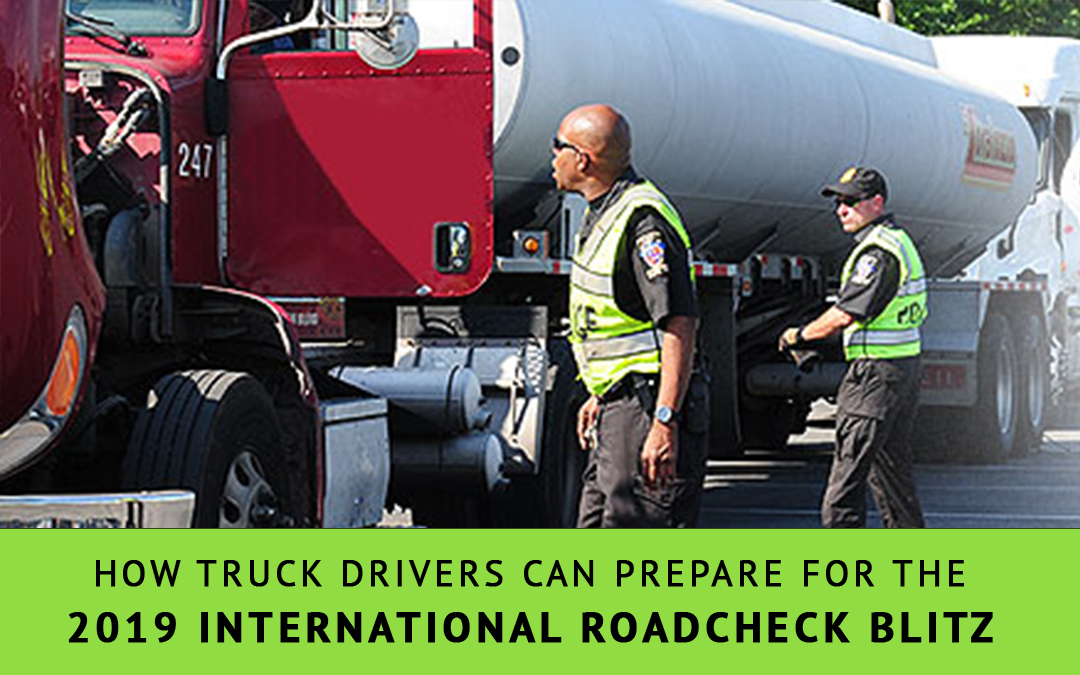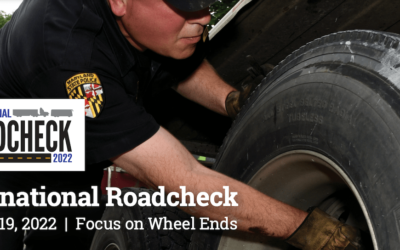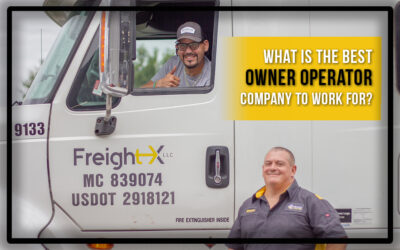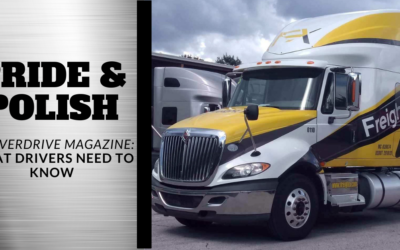From June 4-6, 2019, truck drivers across the country will be subject to the 2019 Commercial Vehicle Safety Alliance (CVSA) International Roadcheck, which is commonly referred to as the safety blitz.
Each year, the CVSA publishes the focus of the blitz, and this year, it’s all about steering and suspension. The goal of this 72-hour annual campaign is to make sure that drivers are being safe and that the road is as safe as it can be.
The CVSA safety blitz is international, and when you look at the amount of trucks that get stopped, it’s between 17-25 inspections per minute!
As a professional truck driver, what do you need to know in order to be prepared for this 2019 inspection blitz?
Preparing for the Steering and Suspension Checks
The focus of the world of drivers needs to be on the steering and suspension.
When you do your Device Vehicle Inspection Report (DVIR), you’re looking at your equipment and inspecting it thoroughly.
If you notice anything – whether it’s in preparation for the 2019 safety blitz or otherwise – be sure you get it fixed before you go back on the road.
Remember that you don’t have to be a mechanic to spot an issue with steering, suspension, or anything else on your truck. Sure, you may not know how to fix it, but you can tell if something isn’t right.
Keep in mind that it’s the same for DOT officers. They aren’t mechanics, either, but they can still tell when something needs to be repaired.
When you do your inspections, it’s just like inspecting your own car, but on steroids.
You should be inspecting your truck every single day – this is your job and we hope you take pride in it! Plus, you are required to do a pre-trip and post-trip inspection.
If you have any doubt about the safety of your truck, you are encouraged to visit the Freight X shop and have one of our mechanics look at it!
Finally, we hold Quarterly Safety Meetings (awesome food, free swag, and raffle prizes are included!), so be sure to follow our Facebook page for announcements on dates. You don’t want to miss those!
Drivers Need to Be Prepared With 8 Days of Clear Logs
While the steering and suspension is the focus of this International Roadcheck, you better believe that your logs will be inspected if you’re pulled aside by a DOT officer.
By law, the DOT officer is allowed to view the last 8 days of your logs. Since this safety blitz is June 4-6, 2019, your logs must be perfectly clear beginning on May 27, 2019 (Memorial Day).
We hate to sound unnecessarily harsh, but if you can’t produce 8 days of clear logs, you shouldn’t be on the road as a professional driver.
While there’s no guarantee that you’ll be pulled over, there is a much higher amount of trucks that will be pulled over during the blitz, so you ought to be prepared. It is recommended that you stay off the road if you have any issues with logs between May 27, 2019 and June 6, 2019.
Tips On Preparing Your Logs and ELD System
These tips apply to this annual safety blitz, but they’re also good to follow all the time, of course!
1. Never hand the DOT officer/inspector your phone.
We definitely mean well, but that DOT officer is not your friend! When you hand them your phone, you’re giving them the opportunity to look through anything.
Instead, you want to send them an inspection report, which supplies the things that are legally required. Basically, you don’t want them to give them anything you don’t have to.
Think about it: if you’re being questioned for a crime, you don’t offer up anything extra. The same thing applies here. Even if everything is 100% perfect and you know that, you’re only going to give what you’re legally required to give.
2. Be sure to have the roadside transfer of logs document.
At Freight X, we use Transflo, and all of our drivers need to know how to operate that Electronics Logs Device (ELD). However, the officer doesn’t!
Keep in mind that there are over 400 approved ELDs – the officer isn’t going to be an expert at every one! However, he will know how to look at the logs, so as a driver you need to know how to operate the logs and your device so you can get the officer what he needs.
That’s why you need the roadside transfer of logs – it’s a 1-page document that shows the officer how the system operates and how to get access to the logs. Generally, you can transfer by email, by website, or your device can be put in inspection mode.
3. Use proper annotations when you stop!
When you stop for fuel, the logs require that you annotate that stop and say why you were stopping. If you stop for fuel, your logs should say fuel stop. If you’re getting unloaded, it should say so. There is not a requirement for on-duty activities, but they are nice to have and good drivers do it, though it is not required.
Our ELD system requires you to put annotations in, but some drivers just type in random letters to get it over with quickly. Don’t do that! It takes no time or effort to put in proper annotations. If an officer sees a bunch of mumbo jumbo on your logs, he will look deeper into them and you’re now susceptible to a violation.
4. Have paper logs prepared as a backup.
According to regulations, you are required to have paper logs in case your device stops working. Essentially, the DOT wants to ensure you have a backup plan. While there’s definitely logic to it, there’s certainly a lot of pushback on that, so I anticipate the regulations to change a bit here in the future.
However, they haven’t yet, so be sure you have paper logs with you, especially during the blitz!
5. Be overly prepared so that you don’t run into state-specific issues.
Every state has different regulations and requirements about what you need to have in your cab. One state might say your CDL is enough, which another might require your CDL and medical card. No matter what state you’re in, you may not know what those DOT officers are trained to ask for.
Be overprepared so that you’re ready for every situation. You want to have all of the potential documents you’ll need, and just in case, we’ve prepared a list of those for you.
Documents You Should Have In Your Cab | Preparing for the Safety Blitz
Part of every inspection is looking at paperwork. So, even though this safety blitz is focused on steering and suspension, you still need all your paperwork to be in order.
The more orderly the information is, the easier it is for everyone, and the faster you can get out of there and get back on the road.
You’re better off having more than you need – and in an organized fashion!
Here’s a quick list of everything you should have with you before you head out for the open road. Please note that there is not a list provided directly from FMCSA – you have to grab it from the different areas of the regulation, and they are all subject to interpretation. However, I put together this list myself to assist drivers.
Driver
- CDL
- Medical Card
CARRIER:
- MC Authority
- IFTA certificate
- MCS-90 form
TRACTOR:
- CAB Card
- Insurance
- AVI truck
- Lease agreement
TRAILER:
- AVI trailer
- Trailer Registration
ELD/LOGS:
- ELD card
- 8-day Backup logs & Inspection reports
- Required Documents
How long is a DOT inspection?
The average DOT inspection is dependent on how prepared you are as a driver. The more prepared you are, the faster it’ll go.
Some inspections – if you have everything in order – can be completed in as little as 10 minutes. On the other hand, it can take 30 minutes to an hour if you’re not prepared.
The emphasis this year is a Level 1 inspection (there are 8 levels total), and that is actually the most thorough inspection you can have. The DOT inspector will test the driver, look at the logs, look at the CAB books, ensure that the driver has all documentation, they walk around the truck, the trailer, and they go underneath the carriage.
That can understandably take some time, but if you’re prepared, you won’t be sitting there for too long!
Where do the safety blitz inspections happen?
Most of the inspections during the 2019 safety blitz will happen at weigh stations. However, they can do it roadside as well.
There you have it – we hope this helps you feel confident for this year’s 2019 safety blitz! If you need any additional assistance, don’t hesitate to contact your dispatcher, myself, or anyone on the Freight X team. Thank you for your hard work and dedication!
By Pat Cook
Related content:



